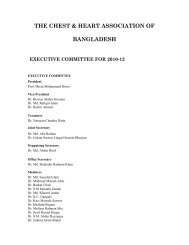Volume. 35, No. 2 july. 2011 - The Chest and Heart Association of ...
Volume. 35, No. 2 july. 2011 - The Chest and Heart Association of ...
Volume. 35, No. 2 july. 2011 - The Chest and Heart Association of ...
You also want an ePaper? Increase the reach of your titles
YUMPU automatically turns print PDFs into web optimized ePapers that Google loves.
<strong>Chest</strong> & <strong>Heart</strong> Journal Vol. <strong>35</strong>, <strong>No</strong>.-2, July <strong>2011</strong>Table-VIIIValidity testValidity test Value (%) 95% CISensitivity 92.0 84.8-96.1Specificity 90.6 83.7-94.5PPV # 90.2 83.1-94.2NPV * 92.3 85.3-96.3Accuracy 91.3 84.2-95.3Positive Likelihood Ratio 9.752Negative Likelihood Ratio 0.088Pre-test probability 48.5%Post test probability (LR +ve) 90.5%Post test probability (LR -ve) 7.5%#PPV = Positive Predictive Value*NPV = Negative Predictive ValueTable VIII shows the validity test <strong>of</strong> C - reactiveprotein in the diagnosis <strong>of</strong> granulomatous pleuritis.Sensitivity, specificity, PPV, NPV <strong>and</strong> accuracywere 92.0%, 90.6%, 90.2%, 92.3% <strong>and</strong> 91.3%respectively. Positive Likelihood Ratio was 9.752which is much more away from 1.0 the base lineto determine the sensitivity. <strong>The</strong> likelihood rati<strong>of</strong>or negative result was 0.088 which indicate that anegative result has less chance to have the diseasewhich intern increases the specificity. At cut <strong>of</strong>fvalue (48mg/l), the pre-test probability <strong>of</strong> CRP valuefor the diagnosis <strong>of</strong> granulomatous pleuritis is48.5% but post test probability at the same cut <strong>of</strong>fvalue (48 mg/l) is 90.5% which indicate that thetest is applicable for the diagnosis <strong>of</strong> granulomatouspleuritis.Table-IXDistribution <strong>of</strong> CRP with ADA results <strong>and</strong>biopsied pleural tissue (granuloma positive)CRP ADA positive Biopsy forGranulomapositiveCRP Positive n=51 46 (69.7) 46 (92.0)CRP Negative n=52 20 (30.3) 04 (08.0)Total n=103 66 (100.0) 50 (100.0)Number within parenthesis indicate percentageTable IX shows the distribution <strong>of</strong> CRP with ADAresults <strong>and</strong> biopsied pleural tissue granulomapositive. Among the 103 patients with pleuraleffusion 51 were CRP positive <strong>and</strong> 52 CRP negative.Among the 66 patients with ADA positive 46 wereCRP positive <strong>and</strong> 20 CRP negative. Among the 50patients with granulomatous pleuritis positive 46were CRP positive <strong>and</strong> 4 CRP negative. All theCRP positive cases were positive for both ADA <strong>and</strong>granuloma.Fig.-3: Validity testDiscussion:C-reactive protein (CRP) in pleural fluid have beenfound to be higher in tuberculosis <strong>and</strong>parapneumonic effusions than in other causes <strong>of</strong>pleural effusion 18 . <strong>The</strong> present cross sectionalstudy was conducted between the period <strong>of</strong> January2010 to December 2010 in the Department <strong>of</strong>Respiratory Medicine, National Institute <strong>of</strong>Diseases <strong>of</strong> the <strong>Chest</strong> <strong>and</strong> Hospital, Mohakhali,Dhaka. <strong>The</strong> present study was conducted withthe aim to find out that the C - reactive protein isa sensitive <strong>and</strong> specific marker for the diagnosis<strong>of</strong> patients with granulomatous pleuritis. Total103 patients with clinically <strong>and</strong> radiologicallydiagnosed pleural effusion were included in thestudy.In the present study out <strong>of</strong> 103 patients withpleural effusion 74 were male <strong>and</strong> 29 were female.Male <strong>and</strong> female ratio was 1.9:1. Mean ± SD <strong>of</strong> age<strong>of</strong> the patient was 50.24 ± 18.38 years. Among themale highest number <strong>of</strong> patients were in the agegroup <strong>of</strong> 51 to 60 years (29.1%) followed by 61 to 70years (18.9%). Other age groups were d”20 years,20-30 years, 31-40 years, 41-50 years <strong>and</strong> more than70 years were 08 (10.8%), 06 (08.1%), 09 (12.2%),08 (10.8%) <strong>and</strong> 07 (09.5%) respectively. Mean ± SD<strong>of</strong> age <strong>of</strong> male was 50.73 ± 19.27 years. Among thefemale highest number <strong>of</strong> patients were in the agegroup <strong>of</strong> 51 to 60 years (27.6%) followed by 41 to 5082



